When you're choosing between suede and leather, you'll encounter two distinctly different materials that come from the same source. While both are derived from the underside of animal hides, their processing methods, characteristics, and practical applications couldn't be more different. Understanding the differences between suede and leather is crucial, as each material is made from the underside of animal hides and brings its own set of advantages and limitations to the table. You'll need to understand these key variations to make an informed decision about which material suits your specific needs.
Key Takeaways
- Suede comes from the inner layer of animal hide with a fuzzy texture, while leather uses the outer layer with a smooth finish.
- Leather offers superior durability and moisture resistance, making it more suitable for high-wear items than suede.
- Suede requires more intensive maintenance, including regular brushing and waterproofing, while leather needs only basic cleaning and conditioning.
- Leather develops an attractive patina over time, whereas suede maintains a consistent matte appearance throughout its lifetime.
- Leather typically costs more but offers better longevity, while suede provides a more affordable option for seasonal fashion items.
Understanding Suede and Leather
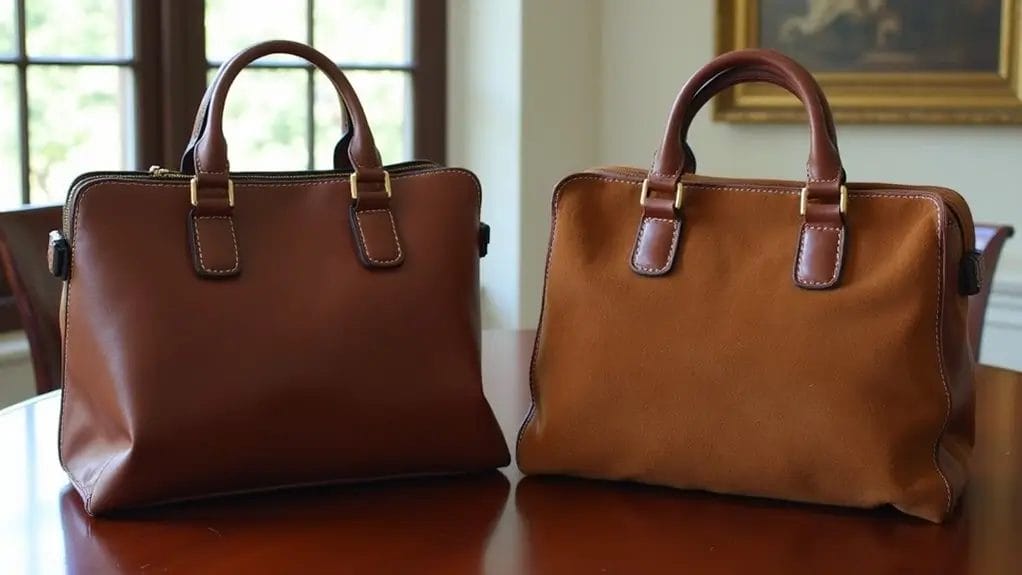
You'll encounter suede as a material crafted from the flesh side of animal hides, resulting in its characteristic soft, napped surface with a velvety texture.
In contrast, leather comes from the exterior grain side of animal hides, featuring a smooth, durable surface that showcases natural patterns and markings.
While both materials originate from animal hides, their distinct processing methods and the specific hide layers used create fundamentally different characteristics in texture, appearance, and durability.
What is Suede?
Suede emerges from the flesh side of animal hides, creating a distinctive soft and fuzzy texture that sets it apart from traditional leather. Suede is a type of split leather, produced through chrome tanning, which results in a uniformly soft finish.
You'll find that suede's characteristic nap is fluffier and softer than nubuck, primarily because it's crafted from the hide's inner layer rather than the outer grain.
While it's a more affordable option, suede is generally less durable compared to leather. You'll need to maintain suede regularly, which includes routine brushing and applying waterproofing treatments to preserve its unique texture and extend its lifespan.
What is Leather?
A classic material in fashion and furniture, leather originates from the outer grain layer of animal hides, primarily cattle. Through leather production processes like chrome and vegetable tanning, you'll find this material develops exceptional durability and a distinctive smooth finish.
Unlike its counterpart suede, leather retains the natural characteristics of the hide, including unique markings and textures. You'll notice leather's superior water resistance and easier maintenance requirements, though proper care remains essential for longevity.
The material's robust nature stems from utilizing the hide's outer layer, creating a polished surface that's both practical and aesthetically pleasing. Leather is often chosen for items that experience frequent use due to its resilience and lasting quality.
Key Differences Between Suede and Leather
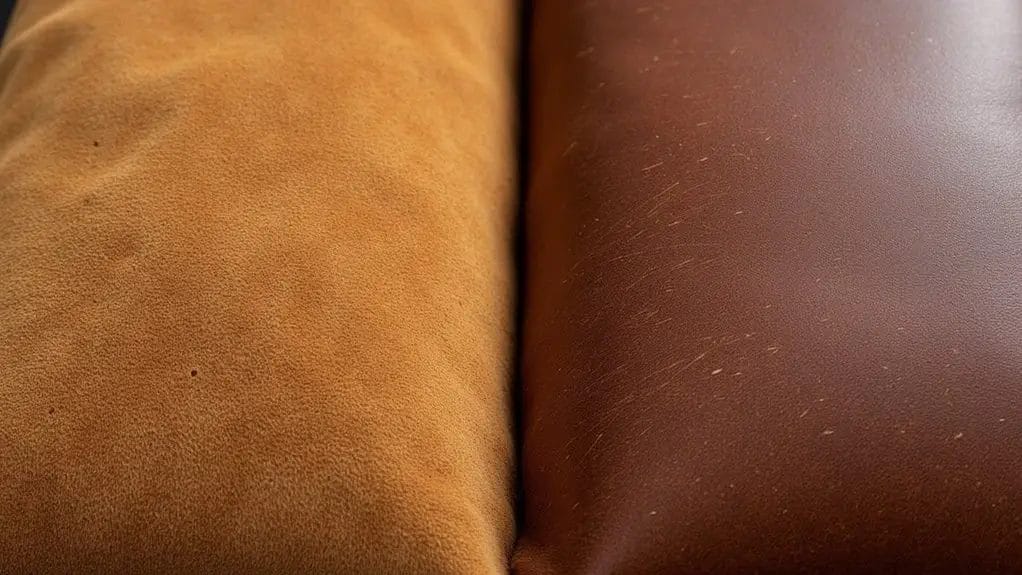
You'll notice immediate differences between leather and suede in their distinctive textures, with leather displaying a smooth, polished surface while suede exhibits a consistently soft, fuzzy nap.
When comparing durability, leather's outer-grain construction provides superior resistance to wear and moisture, whereas suede's inner-layer composition makes it more susceptible to damage and staining.
The maintenance requirements reflect these material differences, as leather typically needs only routine conditioning to maintain its appearance, while suede demands specialized protectants and careful cleaning techniques to preserve its delicate surface.
Texture and Appearance
While both materials originate from animal hides, the texture and appearance of suede and leather couldn't be more distinct.
You'll notice suede's characteristic nap creates a soft, fuzzy surface with a consistent matte finish, derived from the flesh side of the hide. In contrast, leather exhibits a smooth, polished surface that showcases the natural grain patterns of the outer hide.
When you examine leather closely, you'll observe unique markings, pores, and occasional imperfections that add character to the material.
Suede's uniform texture appeals to those seeking softness and visual consistency, while leather's glossy finish and natural variations attract those who appreciate authentic hide characteristics.
Durability Comparison
Considering the structural composition of both materials, leather demonstrates superior durability over suede in nearly every practical application.
You'll find that leather's outer grain structure provides natural resistance against wear and tear, while suede's softer flesh-side construction makes it more vulnerable to damage.
When it comes to leather care, you won't need to maintain it as frequently as suede, making it a more practical choice for many.
The robust nature of leather allows it to withstand daily stress, moisture, and friction better than its counterpart. High-quality leather can endure significantly more use without showing signs of wear.
While both materials require protective treatments, suede's delicate surface demands more consistent attention to preserve its integrity and prevent deterioration in high-contact areas.
Maintenance and Care
Regular maintenance routines differ considerably between suede and leather due to their distinct surface characteristics.
You'll need to brush suede frequently to remove dirt and maintain its nap, while leather typically requires just a quick wipe with a damp cloth.
Suede's delicate texture demands more intensive care and maintenance, including specialized cleaning methods and careful brushing techniques.
When it comes to waterproofing, you must apply protective sprays more frequently to suede than leather, as leather is often more resistant to water and stain damage.
Both materials require protection from direct sunlight and heat, but suede's vulnerability to water damage makes preventive maintenance particularly essential for preserving its appearance and texture.
Uses of Suede and Leather
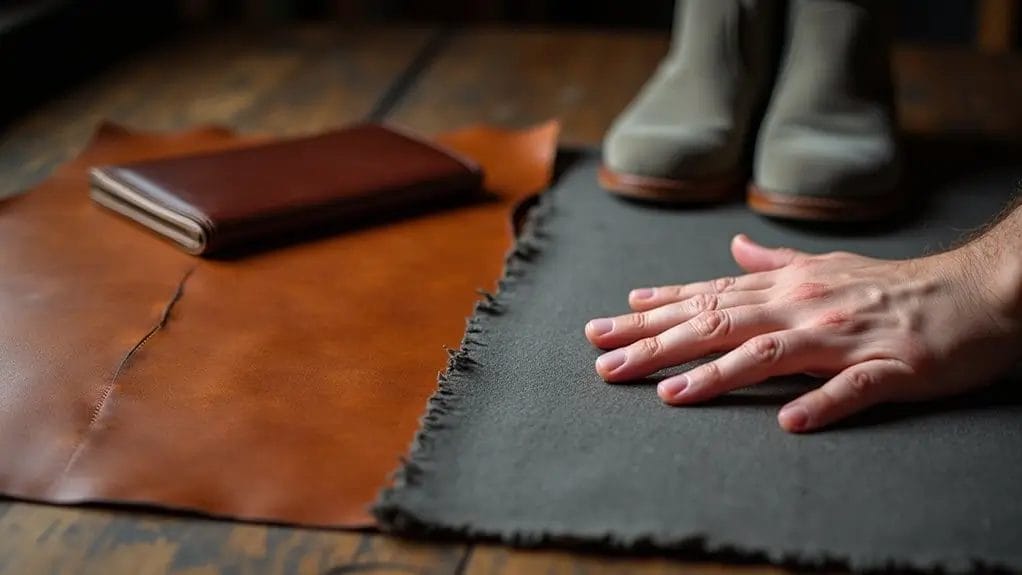
You'll find suede primarily in fashion and accessory items where softness matters most, such as dress shoes, handbags, and clothing pieces that benefit from its plush texture.
Leather's durability makes it the superior choice for everyday accessories like wallets, belts, and structured bags that face constant handling and wear.
In home décor applications, you'll notice leather dominates upholstery and statement furniture pieces, while suede appears more selectively in decorative elements like throw pillows and accent chairs.
Fashion and Accessories
Both suede and leather have carved distinct niches in the fashion and accessories market, each material serving specific style preferences and functional needs.
You'll find suede primarily in fashion-forward pieces where softness and aesthetics take priority, such as designer jackets, trendy shoes, and decorative handbags. Its matte finish and plush texture create a sophisticated yet casual look.
In contrast, leather products excel in items requiring durability and timeless appeal. You'll see leather dominating categories like belts, wallets, and outdoor gear where resilience matters.
While suede offers affordability and style variety, leather commands premium pricing for its lasting quality.
Home Décor
Interior designers frequently incorporate suede and leather into home décor elements, each material bringing distinct advantages to living spaces.
While suede is often selected for its soft, matte finish in upholstery and accent pieces, leather is generally preferred for its durability in high-traffic areas.
- Suede excels in throw pillows, blankets, and cushions, creating cozy, tactile experiences.
- Leather's smooth surface proves ideal for sophisticated sofas, chairs, and statement pieces.
- Suede's affordability makes it accessible for seasonal décor updates and experimentation.
- Leather's easy maintenance and longevity suit permanent fixtures and everyday furniture pieces.
Pros and Cons of Suede vs Leather
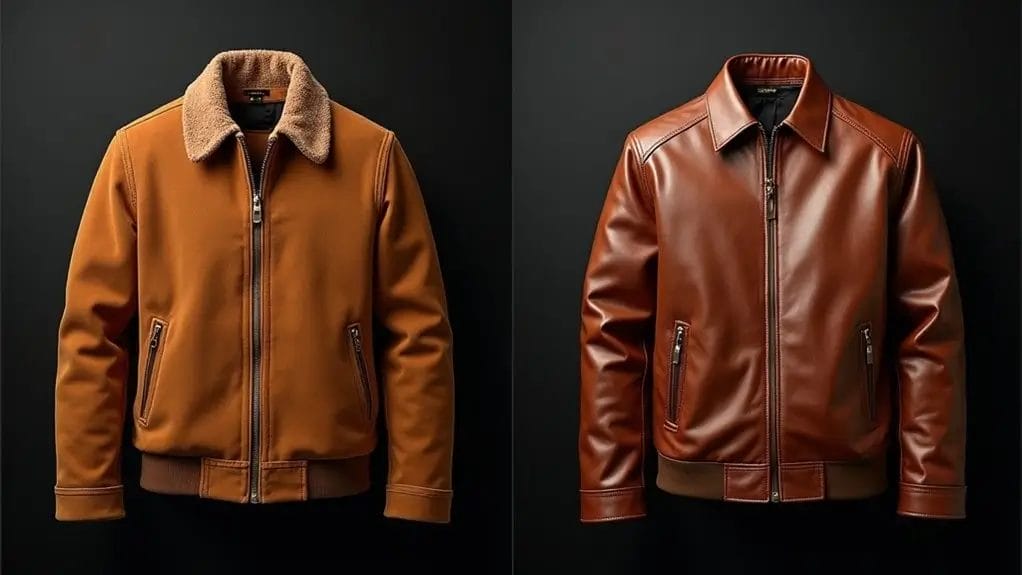
When choosing between suede and leather, you'll find that suede offers affordability and a fashionable matte appearance but comes with significant maintenance requirements and vulnerability to water damage.
Leather provides superior durability and develops an attractive patina over time, though it represents a larger upfront investment and may show scratches more visibly than suede.
You'll need to weigh these trade-offs carefully, considering that suede's soft texture and casual elegance contrast with leather's professional finish and long-term resilience.
Advantages and Disadvantages of Suede
Suede's distinct characteristics present a notable mix of advantages and disadvantages compared to traditional leather.
- Comfort and Aesthetics: You'll find suede offers superior softness and a luxurious matte finish that adds sophistication to various fashion items.
- Cost-Effective Choice: When you're seeking quality materials on a budget, suede presents a more affordable alternative to premium leather options.
- Durability Concerns: Your suede items will show wear more quickly in high-traffic areas and require extra protection against scuffs and scratches.
- Maintenance Requirements: You'll need to invest more time in maintenance, including regular brushing and protecting against water damage, compared to traditional leather's simpler care routine.
Advantages and Disadvantages of Leather
Moving from suede's characteristics, leather presents its own distinct set of advantages and disadvantages in the materials landscape.
You'll find leather's primary strengths in its exceptional durability and superior water resistance, making it ideal for everyday items exposed to frequent wear and varying weather conditions. Its smooth surface develops a rich patina over time, enhancing its aesthetic appeal.
However, leather's disadvantages include its higher price point and initial stiffness that requires breaking in. While you'll spend more upfront, leather's longevity often justifies the investment, particularly in footwear and accessories where durability is essential.
Making the Right Choice
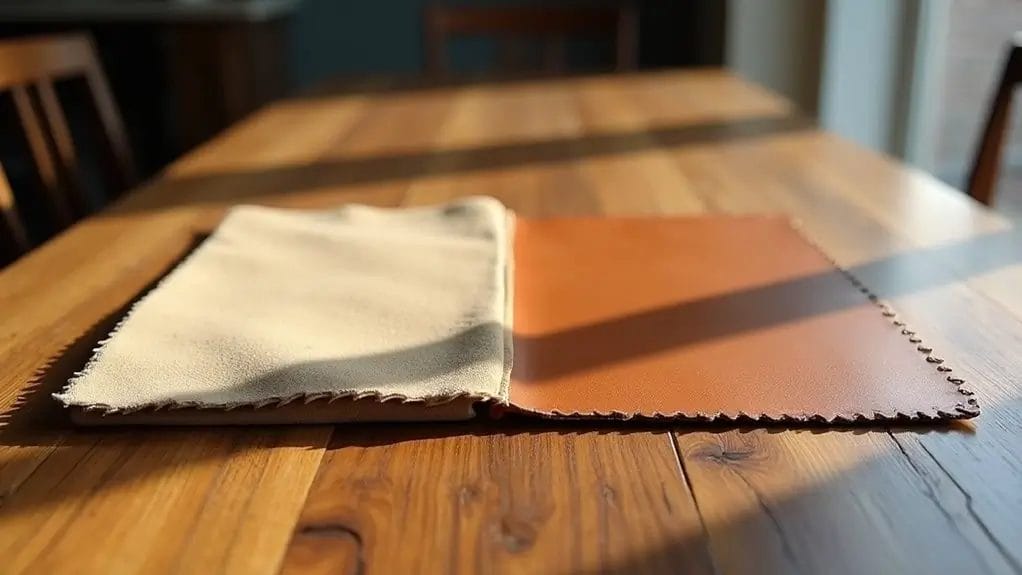
When choosing between suede and leather, you'll need to assess practical factors like durability requirements, maintenance commitment, and intended use of the item.
Your personal style will influence whether you prefer suede's soft, matte aesthetics or leather's sleek, polished appearance.
The decision ultimately comes down to balancing your lifestyle needs with your fashion preferences, as leather offers superior longevity but suede provides unique textural appeal.
Factors to Consider
Making an informed choice between suede and leather requires careful consideration of several key factors.
When evaluating the differences between suede and leather, you'll need to assess your specific needs and preferences to make the best selection.
- Durability: Full-grain leather offers superior wear resistance and longevity, while suede's softer surface makes it more susceptible to damage.
- Maintenance: Leather requires basic cleaning and conditioning, whereas suede demands frequent care to maintain its appearance.
- Application: Consider leather for high-wear items and suede for fashion pieces.
- Budget: Balance initial costs against long-term value, as leather's durability often justifies its higher price point.
Personal Style and Preference
Beyond the practical considerations of durability and maintenance, your personal aesthetic preferences play a significant role in selecting between suede and leather.
If you're drawn to a softer, more casual appearance, suede's matte finish and textured surface might align with your personal style. The material's velvety touch creates a relaxed, contemporary look ideal for casual fashion pieces.
Conversely, if you prefer a polished, timeless aesthetic, leather's smooth surface and classic appeal might better suit your taste.
Your maintenance preferences should also factor into this decision. Suede demands more frequent care to preserve its appearance, while leather maintains its look with minimal upkeep.
Frequently Asked Questions
Are Suede and Suede Leather the Same?
Yes, you'll find that suede and suede leather are identical materials, both created from the flesh side of animal hides. They're processed through sanding to achieve that characteristic soft, napped texture you're familiar with.
What Are the Different Types of Suede?
You'll find several types of suede: traditional suede from lamb, goat, or cow hides; nubuck with its velvety nap; pig suede's durable texture; deerskin's luxurious softness; and micro-suede, a synthetic alternative.
How to Tell Suede or Leather?
You'll identify suede by its soft, velvety nap and matte finish when you touch it. In contrast, you'll notice leather's smooth, polished surface texture and firmer feel under your fingertips.
Which Material Is Better, Suede or Leather?
Your choice depends on your needs: leather's superior durability and water resistance make it better for long-term use, while suede's soft texture and lower cost work well if you're prioritizing comfort and affordability.
Conclusion
When you're choosing between suede and leather, consider your specific needs. You'll find that leather's durability and water resistance make it ideal for high-wear items, while suede's napped texture suits decorative pieces. If you're prioritizing longevity, leather's superior tensile strength and patina development outperform suede. However, if you're seeking a softer, more luxurious aesthetic, suede's distinctive texture delivers unmatched tactile appeal.


0 comments